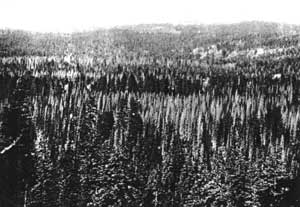In the National Parks, the commercial value of a tree species was irrelevant. Trees provided cover and scenic back drop and the policy at that time was to protect them from fire or insects at almost all costs. As we shall see later in the story, it was a losing battle. And though the beetles essentially won the war, the lessons learned helped bring on a more ecologically enlightened management style decades later.
The purpose of this story is to point out how foresters, land managers, and entomologists reacted to an insect outbreak in Crater Lake National Park during the early 1900s, the lessons they learned, the development of new technology, and how lessons from the past have helped to shape our current pest management policies. Neither the Forest Service nor the Park Service changed or curtailed their bark beetle control policies overnight. The changes took many years and came about after many experiences similar to the one chronicled here.
|
|
Crater Lake was not the only National Park with insect problems. Several others also requested funds to control insects at the time, but the situation at Crater Lake may have been the most serious because of the importance of lodgepole pine as forest cover and the intensity and magnitude of the beetle outbreak. Therefore in late July 1924, Patterson, F.P. Keen, J.M. Miller, and F.C. Craighead of the Bureau of Entomology made a survey of the beetle outbreak. In a report to H.C. Albright, National Park Service Director, Patterson pointed out the gravity of the situation (see footnote 3) and requested $5,000 to start the campaign. It so happened that in 1925 the emergency bill for the U.S. Department of the Interior provided $25,000 for the suppression of insect epidemics in National Parks. This was the first specific appropriation for insect control work in National Parks, and Crater Lake got its share. [4]
The control project in that first year needs to be described in some detail because it set a pattern for future events. [5] To do that, a little must also be known about the technical leader of the project Assistant Entomologist, John E. Patterson, from the U.S. Department of Agriculture, Bureau of Entomology, field station in Ashland, Oregon. [6] John Patterson joined the Bureau of Entomology, Division of Forest Insect Investigations, at its Ashland field station in 1914. Before transferring to the Bureau of Entomology as an entomological ranger, he was a guard at Crater National Forest. He had a varied career earner as a photographer, surveyor’s helper, railroad signal installer, and salesman of packing house products. He was a well-liked and highly competent self-taught entomologist. He published papers on several bark beetle and insect defoliator problems. He was in charge of the Ashland field station from 1921 to 1924 and served as assistant station leader of the Bureau of Entomology’s Berkeley laboratory during the last 8 years of his career. He retired in July 1950 and died on July 31, 1962, in Ashland (see footnote 6).
***previous*** — ***next***


